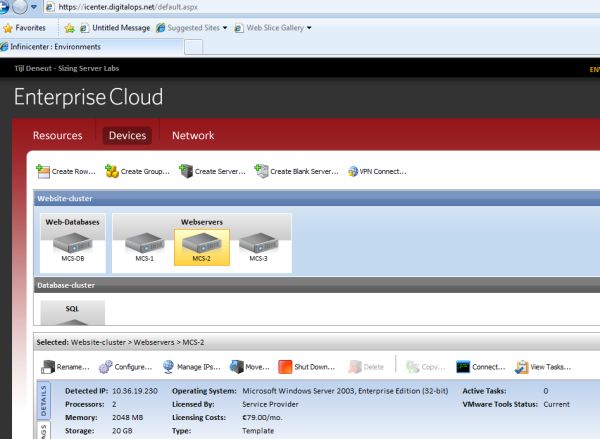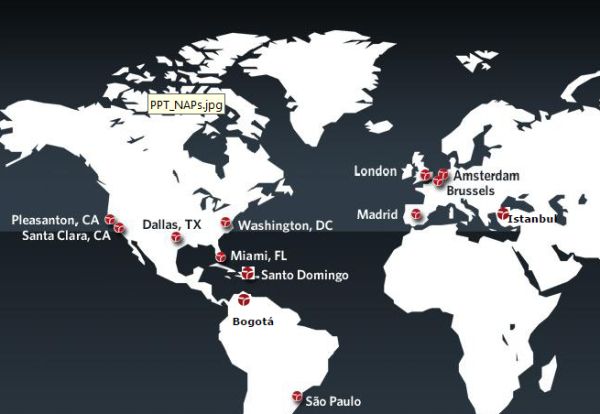Infrastructure as a Service: Benchmarking Cloud Computing
by Johan De Gelas on June 2, 2011 8:50 PM EST- Posted in
- IT Computing
- IT Computing general
- Cloud Computing
More Terremark Enterprise Cloud Details
Another typical IaaS feature is “bursting”. You can see that there is a “disable/enable” burst button. If you enable bursting, you allow your virtual machines to use more than the purchased GHz or RAM space. Of course you pay a premium for the extra resources, but only for the time you really need that extra power. Terremark guarantees that you get a surplus of 20% in all circumstances. If you do not limit your burst capability, you can get what is left in the vSphere resource pool. In our case, we got up to 24GHz, up from the original 5GHz (reserved) and 10GHz (limit).
The networking part is explained here. You can see the internal, external, and public IP addresses. A basic firewall is available.
You can connect to the consoles of each virtual machine via the SSL CISCO AnyConnect VPN client. The final tab in the Environment section is network. Site to Site VPNs is also possible. Depending on where you live, logging in to digitalOps will connect you to one of the European or American data centers of Terremark. Our virtual servers were located in the data center of Amsterdam (the Netherlands). US customers will typically connect to the Miami, Washington DC, Dallas, or Santa Clara data centers.
The Terremark Enterprise Cloud became available in the US at the end of 2008; in the first half of 2009, it was also made available to European customers.













29 Comments
View All Comments
TRodgers - Thursday, June 2, 2011 - link
I like the way you have broken this subject it to small succinct snipets of value information. I work in a place where many of our physical resources are being converted into virtual ones, and it is so often difficult to break down the process, the reasoning, and benefit trees etc to the many different audiences we have.johnsom - Friday, June 3, 2011 - link
You said:Renting 5GB of RAM is pretty straightforward: it means that our applications should be able to use up to 5GB of RAM space.
However this is not always the case with IaaS. vSphere allows memory over committing which allows you to allocate more memory across the virtual machines than the physical hardware makes available. If physical RAM is exhausted your VM gets swap file space tanking your VM memory performance. Likely killing performance when you need it most, peak memory usage.
GullLars - Friday, June 3, 2011 - link
If the pools are well dimentioned, this should almost never happen.If the pagefile is on something like an ioDrive, performance wouldn't tank but be a noticable bit slower. If the pagefile is on spinning disks, the performance would be horrible if your task is memory intensive.
duploxxx - Sunday, June 5, 2011 - link
THat is designing resource pools, if a service company is that idiot they will run out of business.Although swapping on SSD (certainly on next gen vsphere) is another way to avoid the slow performance as much as possible it is still slower and provides Hypervisor overhead.
Ram is cheap, well chosen servers have enough memory allocation.
ckryan - Friday, June 3, 2011 - link
I'm quite pleased with the easy, informative way the article has been presented; I for one would like to see more, and I'm sure future articles on the way. Keep it up, I think it's facinating.JohanAnandtech - Sunday, June 5, 2011 - link
Thank you for taking the time to let us know that you liked the article. Such readers have kept me going for the past 13 years (started in 1998 at Ace's ) :-).HMTK - Monday, June 6, 2011 - link
Yes, you're old :p The main reason I read Anand's these days is exactly for your articles. I liked them at Ace's, like them even more now. Nevertheless, nostalgia sometimes strikes when I think of Aces's and the hight quality of the articles and forums there.bobbozzo - Friday, June 3, 2011 - link
Hi, please include costs of the systems benchmarked... in the case of the Cloud, in $/hour or $/month, and in the case of the server, a purchase price and a lease price would be ideal.Thanks for all the articles!
bobbozzo - Friday, June 3, 2011 - link
Oh, and include electric consumption for the server.krazyderek - Friday, June 3, 2011 - link
i agree, showing a simple cost comparison would have really rounded out this article, it was mentioned several time "you pay for bursting" but how much? put it in perspective for us, relate it to over purchasing hardware for your own data center.